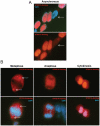Transcription factor STOX1A promotes mitotic entry by binding to the CCNB1 promotor
- PMID: 22253775
- PMCID: PMC3258242
- DOI: 10.1371/journal.pone.0029769
Transcription factor STOX1A promotes mitotic entry by binding to the CCNB1 promotor
Abstract
Background: In this study we investigated the involvement of the transcription factor STOX1A in the regulation of the cell cycle.
Methodology/principal findings: We found that several major cell cycle regulatory genes were differentially expressed upon STOX1A stimulation and knockdown in the neuroblastoma cell line SH-SY5Y. This includes STOX1A dependent differential regulation of cyclin B1 expression, a cyclin which is known to regulate mitotic entry during the cell cycle. The differential regulation of cyclin B1 expression by STOX1A is direct as shown with chromatin immunoprecipitation. Results furthermore suggest that mitotic entry is enhanced through the direct upregulation of cyclin B1 expression effectuated by STOX1A.
Conclusions: In conclusion we hereby show that STOX1A is directly involved in the regulation of the cell cycle.
Conflict of interest statement
Figures





Similar articles
-
SFRS7-mediated splicing of tau exon 10 is directly regulated by STOX1A in glial cells.PLoS One. 2011;6(7):e21994. doi: 10.1371/journal.pone.0021994. Epub 2011 Jul 6. PLoS One. 2011. PMID: 21755018 Free PMC article.
-
RBCK1 drives breast cancer cell proliferation by promoting transcription of estrogen receptor alpha and cyclin B1.Cancer Res. 2010 Feb 1;70(3):1265-74. doi: 10.1158/0008-5472.CAN-09-2674. Epub 2010 Jan 26. Cancer Res. 2010. PMID: 20103625
-
Tubulin-binding agents down-regulate matrix metalloproteinase-2 and -9 in human hormone-refractory prostate cancer cells – a critical role of Cdk1 in mitotic entry.Biochem Pharmacol. 2015 Mar 1;94(1):12-21. doi: 10.1016/j.bcp.2015.01.005. Epub 2015 Jan 20. Biochem Pharmacol. 2015. PMID: 25615907
-
Requirement of Krüppel-like factor 4 in preventing entry into mitosis following DNA damage.J Biol Chem. 2004 Feb 6;279(6):5035-41. doi: 10.1074/jbc.M307631200. Epub 2003 Nov 19. J Biol Chem. 2004. PMID: 14627709 Free PMC article.
-
Cell cycle-dependent phosphorylation of the RUNX2 transcription factor by cdc2 regulates endothelial cell proliferation.J Biol Chem. 2006 Mar 17;281(11):7118-28. doi: 10.1074/jbc.M508162200. Epub 2006 Jan 9. J Biol Chem. 2006. PMID: 16407259
Cited by
-
Identifying genetic susceptibility to Aspergillus fumigatus infection using collaborative cross mice and RNA-Seq approach.Animal Model Exp Med. 2024 Feb;7(1):36-47. doi: 10.1002/ame2.12386. Epub 2024 Feb 14. Animal Model Exp Med. 2024. PMID: 38356021 Free PMC article.
-
Comparative genetic, proteomic and phosphoproteomic analysis of C. elegans embryos with a focus on ham-1/STOX and pig-1/MELK in dopaminergic neuron development.Sci Rep. 2017 Jun 28;7(1):4314. doi: 10.1038/s41598-017-04375-4. Sci Rep. 2017. PMID: 28659600 Free PMC article.
-
Molecular Mechanisms of Trophoblast Dysfunction Mediated by Imbalance between STOX1 Isoforms.iScience. 2020 May 22;23(5):101086. doi: 10.1016/j.isci.2020.101086. Epub 2020 Apr 21. iScience. 2020. PMID: 32371375 Free PMC article.
-
STOX1 Isoform A Promotes Proliferation and Progression of Hepatocellular Carcinoma by Dual Mechanisms of Transcriptionally Upregulation of Cyclin B1 and Activation of ROS-Dependent PTEN/AKT1 Signaling.Cancer Med. 2025 Jul;14(13):e70958. doi: 10.1002/cam4.70958. Cancer Med. 2025. PMID: 40567110 Free PMC article.
-
miR-30a targets STOX2 to increase cell proliferation and metastasis in hydatidiform moles via ERK, AKT, and P38 signaling pathways.Cancer Cell Int. 2022 Mar 4;22(1):103. doi: 10.1186/s12935-022-02503-3. Cancer Cell Int. 2022. PMID: 35246136 Free PMC article.
References
-
- Bloom J, Cross FR. Multiple levels of cyclin specificity in cell-cycle control. Nat Rev Mol Cell Biol. 2007;8:149–60. - PubMed
-
- Woo RA, Poon RY. Cyclin-dependent kinases and S phase control in mammalian cells. Cell cycle. 2003;2:316–24. - PubMed
-
- Porter LA, Donoghue DJ. Cyclin B1 and CDK1: nuclear localization and upstream regulators. Prog Cell Cycle Res. 2003;5:335–47. - PubMed
-
- Murray AW. Recycling the cell cycle: cyclins revisited. Cell. 2004;116:221–34. - PubMed
-
- Pines J. Mitosis: a matter of getting rid of the right protein at the right time. Trends Cell Biol. 2006;16:55–63. - PubMed
MeSH terms
Substances
LinkOut - more resources
Full Text Sources
Molecular Biology Databases
Miscellaneous

